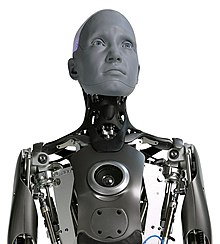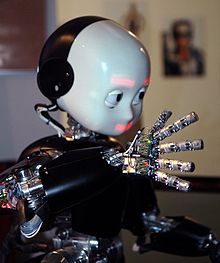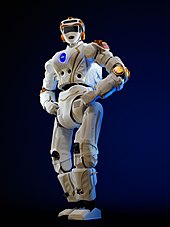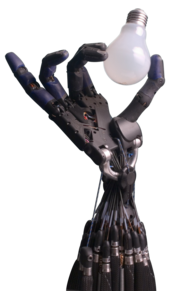
A | B | C | D | E | F | G | H | CH | I | J | K | L | M | N | O | P | Q | R | S | T | U | V | W | X | Y | Z | 0 | 1 | 2 | 3 | 4 | 5 | 6 | 7 | 8 | 9

A humanoid robot is a robot resembling the human body in shape. The design may be for functional purposes, such as interacting with human tools and environments, for experimental purposes, such as the study of bipedal locomotion, or for other purposes. In general, humanoid robots have a torso, a head, two arms, and two legs, though some humanoid robots may replicate only part of the body. Androids are humanoid robots built to aesthetically resemble humans.
History
The concept of a humanoid robot originated in many different cultures around the world. Some of the earliest accounts of the idea of humanoid automata date to the 4th century BCE in Greek mythologies and various religious and philosophical texts from China. Physical prototypes of humanoid automata were later created in the Middle East, Italy, Japan, and France.
Greece
The Greek god of blacksmiths, Hephaestus, created several different humanoid automata in various myths. In Homer's Iliad, Hephaestus created golden handmaidens and imbued them with human-like voices to serve as speaking tools or instruments.[1] Another Greek myth details how Hephaestus crafted a giant bronze automaton named Talos to protect the island of Crete from invaders.[2]
China
In the 3rd century BCE, a Taoist philosophical text called the Liezi, written by Chinese philosopher Lie Yukou, detailed the idea of a humanoid automaton. The text includes mention of an engineer named Yan Shi who created a life-size, human-like robot for the fifth king of the Chinese Zhou Dynasty, King Mu.[3] The robot was primarily constructed of leather and wood. It was capable of walking, singing, and moving all parts of its body.[3]
Middle East
In the 13th century, a Muslim engineer named Ismail al-Jazari designed various humanoid automata. He created a waitress robot that would dispense drinks from a liquid reservoir and appear out of an automatic door to serve them.[4] Another automaton he created was used for hand washing to refill a basin with water after being drained.[5]
Italy

In the 1400s, Leonardo da Vinci conceptualized a complex mechanical robot clad in a suit of armor, capable of sitting, standing, and independently moving its arms.[6] The entire robot was operated by a system of pulleys and cables.
Japan
From the 17th to 19th centuries, the Japanese built humanoid automata called karakuri puppets. These puppets resembled dolls and were used for entertainment in theatre, homes, and religious festivals.[7] Karakuri puppets that were used for theater plays were called butai karakuri.[8] Small karakuri puppets found in homes, called zashiki kurakuri, were placed on tables to dance, beat drums, or serve drinks.[8] The puppets used in religious festivals were known as Dashi karakuri, and they served to reenact myths and legends.[9]
France
In the 18th century, French inventor Jacques de Vaucanson created a significant humanoid automaton called The Flute Player. This wooden, human-sized robot was capable of playing various melodies with the flute. It consisted of a system of bellows, pipes, weights, and other mechanical components to simulate to the muscles necessary to play the flute.[10]
Applications

Humanoid robots are now used as research tools in several scientific areas. Researchers study the human body structure and behavior (biomechanics) to build humanoid robots. On the other side, the attempt to simulate the human body leads to a better understanding of it. Human cognition is a field of study which is focused on how humans learn from sensory information in order to acquire perceptual and motor skills. This knowledge is used to develop computational models of human behavior, and it has been improving over time.
It has been suggested that very advanced robotics will facilitate the enhancement of ordinary humans. See transhumanism.
Medical and research
Humanoid robots are a valuable resource in the world of medicine and biotechnology, as well as other fields of research such as biomechanics and cognitive science.[11] Humanoid robots are being used to develop complex prosthetics for individuals with physical disabilities such as missing limbs.[12] The WABIAN-2 is a new medical humanoid robot created to help patients in the rehabilitation of their lower limbs.[12]
Although the initial aim of humanoid research was to build better orthosis and prosthesis for human beings, knowledge has been transferred between both disciplines. A few examples are powered leg prosthesis for the neuromuscularly impaired, ankle-foot orthosis, biological realistic leg prosthesis, and forearm prosthesis.

Humanoid robots can be used as test subjects for the practice and development of personalized healthcare aids, essentially performing as robotic nurses for demographics such as the elderly.[12] Humanoids are also suitable for some procedurally-based vocations, such as reception-desk administrators and automotive manufacturing line workers. In essence, since they can use tools and operate equipment and vehicles designed for the human form, humanoids could theoretically perform any task a human being can, so long as they have the proper software. However, the complexity of doing so is immense.
Entertainment
Humanoid robots have had a long history in the realm of entertainment, from the conception and ideas in the story of Prometheus to the application and physical build of modern animatronics used for theme parks.[11] Current uses and development of humanoid robots in theme parks are focused on creating stuntronics.[14] Stuntronics are humanoid robots built for serving as stunt doubles, and are designed to simulate life-like, untethered, dynamic movement.[14] Several Disney theme park shows utilize animatronic robots that look, move and speak much like human beings. Although these robots look realistic, they have no cognition or physical autonomy. Various humanoid robots and their possible applications in daily life are featured in an independent documentary film called Plug & Pray, which was released in 2010.
Demonstrative
Though many real-world applications for humanoid robots are unexplored, their primary use is to demonstrate up-and-coming technologies.[15] Modern examples of humanoid robots, such as the Honda Asimo, are revealed to the public in order to demonstrate new technological advancements in motor skills, such as walking, climbing, and playing an instrument.[15] Other humanoid robots have been developed for household purposes, however excel only in single purpose skills and are far from autonomous.[15] Humanoid robots, especially those with artificial intelligence algorithms, could be useful for future dangerous and/or distant space exploration missions, without having the need to turn back around again and return to Earth once the mission is completed.
Sensors
A sensor is a device that measures some attribute of the world. Being one of the three primitives of robotics (besides planning and control), sensing plays an important role in robotic paradigms.
Sensors can be classified according to the physical process with which they work or according to the type of measurement information that they give as output. In this case, the second approach was used.[16]
Proprioceptive
Proprioceptive sensors sense the position, orientation, and speed of the humanoid's body and joints, along with other internal values.[17]
In human beings, the otoliths and semi-circular canals (in the inner ear) are used to maintain balance and orientation.[18] Additionally, humans use their own proprioceptive sensors (e.g. touch, muscle extension, limb position) to help with their orientation. Humanoid robots use accelerometers to measure the acceleration, from which velocity can be calculated by integration;[19] tilt sensors to measure inclination; force sensors placed in robot's hands and feet to measure contact force with environment;[20] position sensors that indicate the actual position of the robot (from which the velocity can be calculated by derivation);[21] and even speed sensors.
Exteroceptive

Arrays of tactels can be used to provide data on what has been touched. The Shadow Hand uses an array of 34 tactels arranged beneath its polyurethane skin on each finger tip.[22] Tactile sensors also provide information about forces and torques transferred between the robot and other objects.
Vision refers to processing data from any modality which uses the electromagnetic spectrum to produce an image. In humanoid robots it is used to recognize objects and determine their properties. Vision sensors work most similarly to the eyes of human beings. Most humanoid robots use CCD cameras as vision sensors.
Sound sensors allow humanoid robots to hear speech and environmental sounds, akin to the ears of the human being. Microphones are usually used for the robots to convey speech.
Actuators
Actuators are the motors responsible for motion in the robot.[23]
Humanoid robots are constructed in such a way that they mimic the human body. They use actuators that perform like muscles and joints, though with a different structure.[23] The actuators of humanoid robots can be either electric, pneumatic, or hydraulic.[24][25] It is ideal for these actuators to have high power, low mass, and small dimensions.[25]
Electric
Electric actuators are the most popular types of actuators in humanoid robots.[24] These actuators are smaller in size, and a single electric actuator may not produce enough power for a human-sized joint.[24] Therefore, it is common to use multiple electric actuators for a single joint in a humanoid robot.[24] An example of a humanoid robot using electric actuators is HRP-2.[25]
Hydraulic
Hydraulic actuators produce higher power than electric actuators and pneumatic actuators, and they have the ability to control the torque they produce better than other types of actuators.[25] However, they can become very bulky in size.[24][25] One solution to counter the size issue is electro-hydrostatic actuators (EHA).[25] The most popular example of a humanoid robot using hydraulic actuators is the ATLAS robot made by Boston Dynamics.[25]
Pneumatic
Pneumatic actuators operate on the basis of gas compressibility.[24][25] As they are inflated, they expand along the axis, and as they deflate, they contract. If one end is fixed, the other will move in a linear trajectory. A popular example of a pneumatic actuator is the Mac Kibben muscle.[25]
Planning and control
Planning in robots is the process of planning out motions and trajectories for the robot to carry out.[26] Control is the actual execution of these planned motions and trajectories.[26] In humanoid robots, the planning must carry out biped motions, meaning that robots should plan motions similar to a human.[27] Since one of the main uses of humanoid robots is to interact with humans, it is important for the planning and control mechanisms of humanoid robots to work in a variety of terrain and environments.[27]
The question of walking biped robots stabilization on the surface is of great importance.[28] Maintenance of the robot's gravity center over the center of bearing area for providing a stable position can be chosen as a goal of control.[28]
To maintain dynamic balance during the walk, a robot needs information about contact force and its current and desired motion.[27] The solution to this problem relies on a major concept, the Zero Moment Point (ZMP).[27]
Another characteristic of humanoid robots is that they move, gather information (using sensors) on the "real world", and interact with it.[29] They do not stay still like factory manipulators and other robots that work in highly structured environments.[29] To allow humanoids to move in complex environments, planning and control must focus on self-collision detection, path planning and obstacle avoidance.[29][30]
Humanoid robots do not yet have some features of the human body.[31] They include structures with variable flexibility, which provide safety (to the robot itself and to the people), and redundancy of movements, i.e. more degrees of freedom and therefore wide task availability.[31] Although these characteristics are desirable to humanoid robots, they will bring more complexity and new problems to planning and control.[32] The field of whole-body control deals with these issues and addresses the proper coordination of numerous degrees of freedom, e.g. to realize several control tasks simultaneously while following a given order of priority.[33][34]
Timeline of developments
| Year | Subject | Notes |
|---|---|---|
| c. 250 BC | Automaton | A humanoid automaton is detailed in the Liezi, written by Chinese philosopher Lie Yukou.[3] |
| c. 50 AD | Automata | Greek mathematician Hero of Alexandria described a machine that automatically pours wine for party guests.[35] |
| 1206 | Ismail Al-Jazari described a band made up of humanoid automata which, according to Charles B. Fowler, performed "more than fifty facial and body actions during each musical selection."[36] Al-Jazari also created hand-washing automata with automatic humanoid servants.[5] His programmable "castle clock" also featured five musician automata which automatically played music when moved by levers operated by a hidden camshaft attached to a water wheel.[37] | |
| 1495 | Leonardo's robot | Leonardo da Vinci designs a humanoid automaton clad in a suit of knight's armor and operated by pulleys and cables.[6] |
| 1738 | The Flute Player | Jacques de Vaucanson builds The Flute Player, a life-size automaton capable of playing different melodies on the flute.[10] |
| 1774 | Pierre Jacquet-Droz and his son Henri-Louis created the Draughtsman, the Musicienne and the Writer, a figure of a boy that could write messages up to 40 characters long.[38] | |
| 1898 | Nikola Tesla publicly demonstrates his "automaton" technology by wirelessly controlling a model boat at the Electrical Exposition held at Madison Square Garden in New York City during the height of the Spanish–American War.[39] | |
| 1921 | Czech writer Karel Čapek introduced the word "robot" in his play R.U.R. (which stands for "Rossum's Universal Robots"). The word "robot" comes from the word "robota", meaning, in Czech and Polish, "labour, drudgery".[40] | |
| 1927 | Maschinenmensch | The ("machine-human"), a gynoid humanoid robot, also called "Parody", "Futura", "Robotrix", or the "Maria impersonator" (played by German actress Brigitte Helm), one of the earliest humanoid robots ever to appear on film, is depicted in Fritz Lang's film Metropolis. |
| 1928 | Eric | An electrical robot opens an exhibition of the Society of Model Engineers at London's Royal Horticultural Hall in London, and tours the world.[41] |
| 1939 | Elektro | A humanoid robot built by the Westinghouse Electric Corporation[42] |
| 1941-42 | Three Laws of Robotics | Isaac Asimov formulates the Three Laws of Robotics, used in his robot science fiction stories, and in the process of doing so, coins the word "robotics".[43] |
| 1948 | Cybernetics | Norbert Wiener formulates the principles of cybernetics, the basis of practical robotics.[44] |
| 1961 | Unimate | The first digitally operated and programmable non-humanoid robot, is installed on a General Motors assembly line to lift hot pieces of metal from a die casting machine and stack them. It was created by George Devol and constructed by Unimation, the first robot manufacturing company.[45] |
| 1967 to 1972 | WABOT-1 | Waseda University initiated the WABOT project in 1967, and in 1972 completed the WABOT-1, the world's first full-scale humanoid intelligent robot.[46][47] It was the first android, able to walk, communicate with a person in Japanese (with an artificial mouth), measure distances and directions to the objects using external receptors (artificial ears and eyes), and grip and transport objects with hands.[48][49][50] |
| 1969 | D.E. Whitney publishes his article "Resolved motion rate control of manipulators and human prosthesis".[51] | |
| 1970 | Zero Moment Point | Miomir Vukobratović proposed a theoretical model to explain biped locomotion.[52] |
| 1972 | Powered exoskeleton | Miomir Vukobratović and his associates at Mihajlo Pupin Institute build the first active anthropomorphic exoskeleton.[53] |
| 1980 | Marc Raibert established the MIT Leg Lab, which is dedicated to studying legged locomotion and building dynamic legged robots.[54] | |
| 1983 | Greenman | Using MB Associates arms, "Greenman" was developed by Space and Naval Warfare Systems Center, San Diego. It had an exoskeletal master controller with kinematic equivalency and spatial correspondence of the torso, arms, and head. Its vision system consisted of two 525-line video cameras each having a 35-degree field of view and video camera eyepiece monitors mounted in an aviator's helmet.[55] |
| 1984 | WABOT-2 | At Waseda University, the WABOT-2 is created, a musician humanoid robot able to communicate with a person, read a normal musical score with his eyes and play tunes of average difficulty on an electronic organ.[48] |
| 1985 | WHL-11 | Developed by Hitachi Ltd, WHL-11 is a biped robot capable of static walking on a flat surface at 13 seconds per step and it can also turn.[48] |
| 1986 | Honda E series | Honda developed seven biped robots which were designated E0 (Experimental Model 0) through E6. E0 was in 1986, E1 – E3 were done between 1987 and 1991, and E4 - E6 were done between 1991 and 1993.[56] |
| 1989 | Manny | A full-scale anthropomorphic robot with 42 degrees of freedom developed at Battelle's Pacific Northwest Laboratories in Richland, Washington, for the US Army's Dugway Proving Ground in Utah. It could not walk on its own but it could crawl, and had an artificial respiratory system to simulate breathing and sweating.[48] |
| 1990 | Tad McGeer showed that a biped mechanical structure with knees could walk passively down a sloping surface.[57] | |
| 1993 | Honda P series | Honda developed P1 (Prototype Model 1) through P3, an evolution from E series, with upper limbs. Developed until 1997.[56] |
| 1995 | Hadaly | Developed in Waseda University to study human-robot communication and has three subsystems: a head-eye subsystem, a voice control system for listening and speaking in Japanese, and a motion-control subsystem to use the arms to point toward campus destinations.[58] |
| 1995 | Wabian | A human-size biped walking robot from Waseda University.[58] |
| 1996 | Saika | A light-weight, human-size and low-cost humanoid robot, was developed at Tokyo University. Saika has a two-DOF neck, dual five-DOF upper arms, a torso and a head. Several types of hands and forearms are under development also. Developed until 1998.[48] |
| 1997 | Hadaly-2 | A humanoid robot designed in Waseda University which realizes interactive communication with humans. It communicates not only informationally, but also physically.[58] |
| 2000 | ASIMO | Honda creates its 11th bipedal humanoid robot, able to run.[56] |
| 2001 | Qrio | Sony unveils small humanoid entertainment robots, dubbed Sony Dream Robot (SDR). Renamed Qrio in 2003.[59] |
| 2001 | HOAP | Fujitsu realized its first commercial humanoid robot named HOAP-1. Its successors, HOAP-2 and HOAP-3, were announced in 2003 and 2005, respectively. HOAP is designed for a broad range of applications for R&D of robot technologies.[60] |
| 2002 | HRP-2 | A biped walking robot built by the Manufacturing Science and Technology Center (MSTC) in Tokyo.[61] |
| 2003 | JOHNNIE | An autonomous biped walking robot built at the Technical University of Munich. The main objective was to realize an anthropomorphic walking machine with a human-like, dynamically stable gait.[62] |
| 2003 | Actroid | A robot with realistic silicone "skin" developed by Osaka University in conjunction with Kokoro Company Ltd.[63] |
| 2004 | Persia | Iran's first humanoid robot, was developed using realistic simulation by researchers of Isfahan University of Technology in conjunction with ISTT.[64] |
| 2004 | KHR-1 | A programmable bipedal humanoid robot introduced in June 2004 by a Japanese company Kondo Kagaku. |
| 2005 | PKD Android | A conversational humanoid robot made in the likeness of science fiction novelist Philip K Dick, was developed as a collaboration between Hanson Robotics, the FedEx Institute of Technology, and the University of Memphis.[65] |
| 2005 | Wakamaru | A Japanese domestic robot made by Mitsubishi Heavy Industries, primarily intended to provide companionship to elderly and disabled people.[66] |
| 2005 | Actroid | The Geminoid series is a series of ultra-realistic humanoid robots developed by Hiroshi Ishiguro of ATR and Kokoro in Tokyo. The original one, Geminoid HI-1, was made at its image. Followed Geminoid-F in 2010 and Geminoid-DK in 2011.[67] |
| 2006 | Nao | A small open source programmable humanoid robot developed by Aldebaran Robotics, in France. Widely used by worldwide universities as a research platform and educational tool.[67] |
| 2006 | REEM-A | The first fully autonomous European biped humanoid robot, designed to play chess with the Hydra Chess engine. The first robot developed by PAL Robotics, it was also used as a walking, manipulation, speech and vision development platform.[68] |
| 2006 | iCub | A biped humanoid open source robot for cognition research.[69] |
| 2006 | Mahru | A network-based biped humanoid robot developed in South Korea.[70] |
| 2007 | TOPIO | A ping pong playing robot developed by TOSY Robotics JSC.[71] |
| 2007 | Twendy-One | A robot developed by the WASEDA University Sugano Laboratory for home assistance services. It is not biped, as it uses an omni-directional mobile mechanism.[72] |
| 2008 | Justin | A humanoid robot developed by the German Aerospace Center (DLR).[73] |
| 2008 | Nexi | The first mobile, dexterous, and social robot, makes its public debut as one of TIME magazine's top inventions of the year.[74] The robot was built through a collaboration between the MIT Media Lab Personal Robots Group,[75] UMass Amherst and Meka Robotics.[76][77] |
| 2008 | Salvius | The first open source humanoid robot built in the United States is created.[78] |
| 2008 | REEM-B | The second biped humanoid robot developed by PAL Robotics. It has the ability to autonomously learn its environment using various sensors and carry 20% of its own weight.[79] |
| 2008 | Surena | It had a height of 165 centimetres and weight of 60 kilograms, and is able to speak according to predefined text. It also has remote control and tracking ability.[80] |
| 2009 | HRP-4C | A Japanese domestic robot made by National Institute of Advanced Industrial Science and Technology, shows human characteristics in addition to bipedal walking.[81] |
| 2009 | Kobian | A robot developed by Waseda University can walk, talk, and mimic emotions.[82] |
| 2009 | DARwIn-OP | An open source robot developed by ROBOTIS in collaboration with Virginia Tech, Purdue University, and University of Pennsylvania. This project was supported and sponsored by NSF.[83] |
| 2010 | Robonaut 2 | A very advanced humanoid robot by NASA and General Motors. It was part of the payload of Shuttle Discovery on the successful launch February 24, 2011. It is intended to do spacewalks for NASA.[84] |
| 2010 | HRP-4C | National Institute of Advanced Industrial Science and Technology demonstrate their humanoid robot singing and dancing along with human dancers.[85] |
| 2010 | REEM | A humanoid service robot with a wheeled mobile base. Developed by PAL Robotics, it can perform autonomous navigation in various surroundings and has voice and face recognition capabilities.[86] |
| 2011 | ASIMO | In November, Honda unveiled its second generation Honda Asimo Robot. The all new Asimo is the first version of the robot with semi-autonomous capabilities.[87] |
| 2012
Zdroj:https://en.wikipedia.org?pojem=Humanoid_robot Text je dostupný za podmienok Creative Commons Attribution/Share-Alike License 3.0 Unported; prípadne za ďalších podmienok. Podrobnejšie informácie nájdete na stránke Podmienky použitia.
Analytika
Antropológia Aplikované vedy Bibliometria Dejiny vedy Encyklopédie Filozofia vedy Forenzné vedy Humanitné vedy Knižničná veda Kryogenika Kryptológia Kulturológia Literárna veda Medzidisciplinárne oblasti Metódy kvantitatívnej analýzy Metavedy Metodika Text je dostupný za podmienok Creative
Commons Attribution/Share-Alike License 3.0 Unported; prípadne za ďalších
podmienok. www.astronomia.sk | www.biologia.sk | www.botanika.sk | www.dejiny.sk | www.economy.sk | www.elektrotechnika.sk | www.estetika.sk | www.farmakologia.sk | www.filozofia.sk | Fyzika | www.futurologia.sk | www.genetika.sk | www.chemia.sk | www.lingvistika.sk | www.politologia.sk | www.psychologia.sk | www.sexuologia.sk | www.sociologia.sk | www.veda.sk I www.zoologia.sk |
